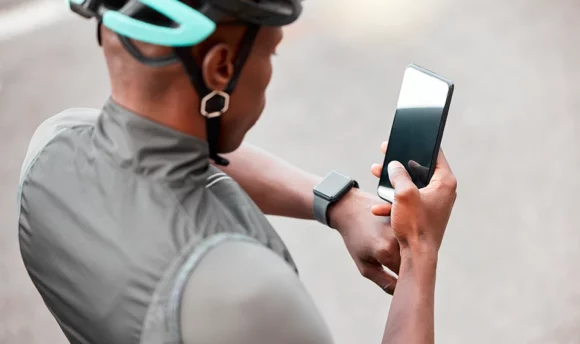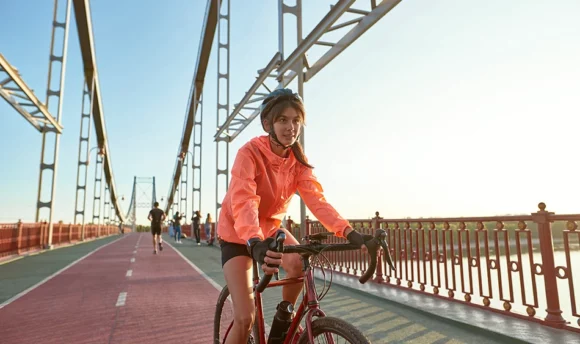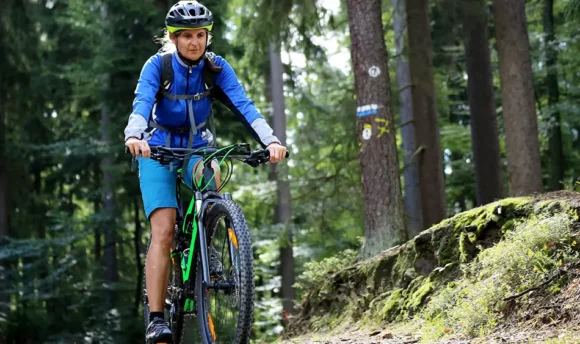Effects of Cycling on Body Shape: Benefits, Results
Cycling, in general, helps in targeting a vast portion of our muscles. But how does that play into your resulting body shape? In this article, we will be talking about the body shape disparity that exists amongst cyclists. We will also look at the many health benefits linked with it. So join us on this fun ride.

Cycling is one of the best ways to improve your cardiorespiratory system, endurance, and stamina levels. It is also easy to burn a decent amount of calories and develop your muscles.
However, how does it scale when it comes to giving you your desired body shape? What truly is the effect of cycling on body shape?
In today’s article, we will be looking at what goes into achieving your body goals and how cycling prepares you to achieve them. Please stick with us because this will undoubtedly be a fun ride.
What Muscle Areas Does Cycling Target?
Cycling, a leg-dominant sport, primarily engages the muscle groups in your lower body, such as your quads, hamstrings, glutes, and calves. The effort put into rotating the pedal and thus driving the bicycle helps build muscle mass and definition.
Cycling also targets specific muscle groups in your upper body, like those on your arms and shoulders, albeit the effects are not as dominant as those felt on your lower body.
Let us briefly examine each of the major muscle groups used while cycling.
Glutes
The gluteal muscles, which we are familiar with as the buttocks, are the biggest muscle mass in the entire body. The gluteal muscles, located at the back of the hip, consist of the gluteus maximus, medius, and minimus.
These muscles, having one on either side of the body, are responsible for moving the thighs, cooperating with the hip to produce rotational movement, and keeping the body upright.
The gluteal muscles engage most while actively pedaling the bicycle, especially when in a sitting position. Being the powerhouse of your pedal stroke, building your glutes will help alleviate knee pain and back pain caused by overworking your thighs.
Thighs
Your hamstrings and quadriceps, which combine to make up the thigh muscles, are the most active leg muscles in cycling. That is because they tirelessly push down on and bring up the pedals.
However, your thigh muscles are only second in muscle engagement, falling behind the calf muscles.
Your cycling intensity primarily centers on how hard you pedal and determines how toned your legs eventually become. The cycling intensity when using a road bike depends mainly on the terrain you ride. On the other hand, you can manually adjust the resistance when using a stationary bike.
Calves
The most prominent body feature of any cyclist is their calves, and that is because the calf muscles are the most engaged muscles during cycling.
The calf muscles consist of two sections – the gastrocnemius and the soleus, which come together just above the heel and then attach to the Achilles tendon. These muscles work while cycling because the gastrocnemius facilitates motion for cyclists, while the soleus helps raise the heel to pedal.
Again, the intensity of the exercise leads to more toned muscles.
Arms
Aside from having stacked legs, your triceps and biceps receive good stimulation when cycling, as they help provide support, control, and stabilization.
Compared to indoor cycling or cycling on flat grounds, cycling on rough terrains will strengthen your arm muscles and produce better definition because you use more force to pull on the handlebars, counteracting downforce.
Shoulders
Your deltoids are another upper body group that accounts for stability and balance during cycling. Cycling using improper form puts tons of pressure on your delts, eventually leading to upper back pain.
Core
The upper and lower abdominal muscles combine to make up the core. These muscles help provide spinal support and stability, especially when maintaining posture while cycling outdoors on uneven terrains.
Cycling uphill and out of your saddle prompts your core muscles to contract and flex, and this helps burn belly fat.
Nonetheless, it is safe to say that proper muscle development will lead to being able to provide more power to your bicycle wheels and prevent certain cycling injuries.
That is why you should augment your cycling workout with strength training. Squats, leg presses, deadlifts, lunges, etc., will lead to bigger and stronger calf and quad muscles.
Still, it is worth noting that you can only improve your muscle gain by following a strict training plan. Cycling Diet helps you stay consistent in your training routine irrespective of your cycling goals.
The app features a combination of personalized training programs and meal plans to allow cyclists to excel totally, whether that involves weight loss, fitness level maintenance, or concentration improvement.
What Are the Effects of Cycling on Body Shape?
Whether male or female, cycling offers several benefits when it comes to getting your desired body shape. With that, we will be looking at the effect of cycling on body shape.
Low impact
Unlike running, which puts tons of pressure on your joints, thereby leading to more injuries, cycling is relatively easygoing, as it offers similar physical benefits while being low-impact.
A study centered on professional runners and track cyclists exercising 2.5 hours for 3 days revealed that the runners suffered more muscle damage and inflammation than the cyclists.
In that sense, cycling is the cardiovascular exercise routine for those with joint concerns and flexibility issues.
Larger legs
Since cycling is a leg-dominant sport, it is evident that you will start to see changes in your leg shape and size after a couple of weeks.
However, it would be best to remember that the development of leg muscles ultimately falls on many factors like workout intensity. For example, track cyclists typically have larger legs than those doing indoor cycling because they must apply total effort over short periods.
Still, the leg size of track cyclists does not come from their intense cycling sessions. Instead, they spend significant time in the gym doing weight training.
Toned arms
As mentioned earlier, the challenges attributed to cycling repeatedly on rugged terrains allow you to strengthen your arm muscles over time.
That is because you experience more opposition when riding on rugged paths than on leveled grounds; thus, you need stronger arms to stabilize and guide you. Muscular arms enable you to maintain a position for extended periods before fatigue sets in.
Flat stomach
Like any other aerobic exercise, cycling is an excellent way to burn stubborn belly fat, giving you your desired belly size.
However, it is important to note that cycling does not target your abdominal region’s fats. Instead, prolonged cycling leads to burning more calories – a prerequisite for shedding more body fat and core muscle workout.
Does cycling affect females and males differently?
Regarding the two sexes, biological differences and natural body shape play critical roles in determining overall cycling body transformation in male and female cyclists.
When it comes to muscle mass, the pivotal factor for developing bigger muscles is the presence of the hormone testosterone. The high amounts of testosterone found in men is a huge reason men tend to be naturally more muscular than women and why gaining muscle mass is much easier.
On the other hand, females have high amounts of estrogen and progesterone; this means that female cyclists would have to put in more effort to gain muscle mass and definition than their male counterparts.
Experts suggest that it takes 12–16 weeks for male cyclists to see noticeable improvements in their transformation, whether that entails weight loss, muscle development, or muscle toning.
Surprisingly, the cycling body transformation for female cyclists mimics that of their male counterparts in terms of fat loss and muscle development. However, the hormonal difference in male and female bodies causes theirs to be much slower.
Then again, a person’s natural body type determines the influence routine cycling will have on them. There are 3 main body types: ectomorphs, endomorphs, and mesomorphs.
Ectomorphs are typically tall and lean and have a high/fast metabolism, causing little body fat and muscles. Endomorphs have more muscles and body fat and are capable of gaining weight quickly. Mesomorphs are like endomorphs but are capable of weight loss and muscle gain at a faster rate.
The different genetic dispositions, coupled with dietary affiliations, will influence the body transformation of any cyclist before and after. Then again, women naturally hold more body fat than men do.
Other Benefits of Cycling Every Day
Aside from the aforementioned effect of cycling on body shape, going on daily bike rides exposes you to a plethora of other health benefits.
In line with that, we will be looking at several other benefits of cycling on a day-to-day basis.
Reduces risks of cardiovascular diseases
Cardiovascular fitness is one of the most important benefits of going on daily bike rides. Research cites lack of sufficient exercise as a major contributor to cardiovascular diseases such as stroke, heart attack, and high blood pressure.
Cycling daily helps strengthen your heart muscles, produce more aerobic cells, enhance respiratory function, and promote proper circulation.
In the same vein, cycling also helps improve cholesterol levels by increasing high-density lipoprotein (HDL) cholesterol levels and reducing low-density lipoprotein (LDL) cholesterol and triglyceride levels.
It also cuts down your exposure to CO2 pollution from cars.
Good for your knee joints
Riding a bike is an ideal workout routine for those that are suffering from joint problems such as arthritis and osteoarthritis. Since it is a low-impact activity, you can dial the intensity without putting stress on your joints.
Still, since cycling is not a weight-bearing activity, unlike running, it does not actively influence osteoporosis.
Strengthening your muscles
Cycling is an excellent means of strengthening your lower body muscles without overstressing your joints. It also engages specific muscles in your upper body.
Mixing in routine weight training will help strengthen your lower body muscles further, improve endurance levels, and enhance cycling performance, ultimately surpassing your limits.
Promotes weight loss
You can lose weight gradually if you cycle daily. For example, scientific evidence shows that cutting 500–1000 calories will allow you to lose one pound in one week.
On average, you can burn about 200–700 calories on a 30 minutes bike ride. However, burning calories depends on speed, body weight, and bike type.
Overall, it would be best if you pair your exercise routine with a proper eating plan, as these factors will allow you to lose weight gradually.
Improves mental health
Leisure bike rides will significantly improve mental health conditions like anxiety, depression, and stress. That is because the exercise prompts the release of endorphin, a chemical that makes you feel good.
It is also great for improving focus, concentration, and awareness. Studies also show that outdoor cycling enhances cognitive functions in older individuals.
FAQ
Here are several questions that frequently pop up when talking about the effect of cycling on body shape.
Doing any cardio workout will burn many calories, prompting you to lose weight. In addition, combined with a calorie deficit, you are bound to appear skinny.
Yes, cycling is a full-body workout.
Yes, cycling regularly engages your core muscles, providing support for your spine and stabilization.
No, riding a bike will not get you ripped. Instead, sign up for a gym membership and begin some weight training to get “ripped.”
Cycling helps grow your lower and upper body by targeting the muscles in your arms, shoulders, core, and legs.
A Word From Our Coach
Influencing your body shape is just one aspect cycling excels at – there are many other reasons why engaging in this exercise is a must for you.
Although, it is a wise idea to plan a workout routine that sees you gaining from all the benefits of frequent cycling. So, you should constantly find ways to improve your workout patterns and keep it fun.
If you are unsure how to go about it, consider getting help from your local coach. They have years of experience under their belt and will be able to guide you through your fitness journey.
Conclusion
As much as you want to gain the ultimate body transformation, you must understand that being underweight comes with its fair share of challenges.
You stand a greater chance of suffering from injuries and falling off cardiovascular health. But, when done right, cycling will help you lose weight, build muscles, and achieve an excellent body shape.

















































 Select your language:
Select your language: 








